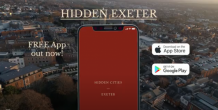Articles

The free app gives fascinating information about the lives and times of ordinary men and women linked to Exeter’s historic landmarks.
Step back in time to explore Exeter with characters living through the city’s most dramatic moments
A colourful cast of characters living through Exeter’s most dramatic moments are bringing the city’s history to life thanks to new research.
The Hidden Exeter app allows people to navigate through the city using period and modern maps, exploring key landmarks.
The free app gives fascinating information about the lives and times of ordinary men and women linked to Exeter’s historic landmarks. There are audio trails led from Exeter residents of the 16th century, with two new trails now available.
The app is a result of work led by Professor Fabrizio Nevola from the University of Exeter, who works to develop smartphone apps to help bring Europe’s history to life using GPS-triggered city audio tours which recreate the urban streets of the past.
One walk is led by Joan Redwood, a baker’s widow. Joan is a real-life character who left a will and inventory of her household goods from which the basics of her life can be reconstructed. Set in 1586, her journey to eight historic sites sheds light on her life as a wife, mother and now a working widow. Walking with Joan, users of the Hidden Cities app will encounter the city’s corn mills and a climb up the blood-soaked Butcher Row. They’ll also take a sneaky look through a parlour window and pause for thought in a church porch. Along the way, the walk uses rare snippets of information from Exeter’s archives to shed light on the way a selection of Elizabethan women negotiated their world. Joan takes walkers to Cricklepit Mill, the Guildhall and St Katherine’s Almshouses.
Another new walk is led by Elizabeth, a brewstress, and her brother William a wool tucker, who lived in Exeter in 1536, when England’s monasteries were being closed – including St Nicholas Priory where Henry VIII’s agents have arrived to strip away its valuables. Elizabeth works for the monks and leads a furious resistance. Her brother, a master craftsman, has Protestant sympathies and is more fearful of defying the King. This walk takes in St Nicholas Priory, Tucker’s Hall, the Guildhall and St Olave’s Church. This walk was created through collaboration between University of Exeter students, The Royal Albert Memorial Museum and Art Gallery and St Nicholas’ Priory, using research about the reformation by Professor James Clark from the University of Exeter.
Also on the app is a walk led by Thomas Greenwood, a haberdasher from 1588. He is a newly appointed city steward and discusses plans for a new Guildhall, markets, the city walls, military gatherings, Exeter’s inns and new forms of worship after the Reformation. Walkers see the Guildhall and city walls.
Professor Nevola said: “I hope people will enjoy meeting Joan, Elizabeth and William. Walking with them will allow people to explore Exeter in a new way, taking in the sights and sounds of the early modern city. So many of the landmarks they knew are still standing today and using an audio trail and old maps helps people experience Tudor Exeter.”
The Hidden Exeter app is available from AppStore and GooglePlay. It can also be found in the “maps” app on Apple phones.
“Hidden Cities” is the result of a three year (2019-22) collaborative research project “Public Renaissance: Urban Cultures of Public Space between Early Modern Europe and the Present” funded by the Humanities in the European Research Area (HERA).
Date: 21 February 2022
